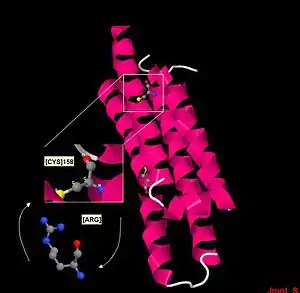Familial dysbetalipoproteinemia
Familial dysbetalipoproteinemia or type III hyperlipoproteinemia is a condition characterized by increased total cholesterol and triglyceride levels, and decreased HDL levels.[2]:534
| Familial dysbetalipoproteinemia | |
|---|---|
| Other names | Remnant hyperlipidemia, Remnant hyperlipoproteinaemia, Broad beta disease[1] and Remnant removal disease[1] |
 | |
| Familial dysbetalipoproteinemia is caused by this point mutation in ApoE | |
| Specialty | Medical genetics, endocrinology |
Signs and symptoms
Signs of familial dysbetaproteinemia include xanthoma striatum palmare (orange or yellow discoloration of the palms) and tuberoeruptive xanthomas over the elbows and knees. The disease leads to premature atherosclerosis and therefore a possible early onset of coronary artery disease and peripheral vascular disease leading to a heart attack, i.e. myocardial infarction, chest pain on exercise, i.e. angina pectoris or stroke in young adults or middle aged patients.[3]
Causes
This condition is caused by a mutation in apolipoprotein E (ApoE), that serves as a ligand for the liver receptor for chylomicrons, IDL and VLDL, also known as very-low-density-lipoprotein receptor. The normal ApoE turns into the defective ApoE2 form due to a genetic mutation.[4] This defect prevents the normal metabolism of chylomicrons, IDL and VLDL, otherwise known as remnants, and therefore leads to accumulation of cholesterol within scavenger cells (macrophages) to enhance development and acceleration of atherosclerosis.
Treatment
First line of management are fibrates.
See also
- Primary hyperlipoproteinemia
- Apolipoprotein B deficiency
- List of cutaneous conditions
References
- Rapini, Ronald P.; Bolognia, Jean L.; Jorizzo, Joseph L. (2007). Dermatology: 2-Volume Set. St. Louis: Mosby. ISBN 978-1-4160-2999-1.
- James, William D.; Berger, Timothy G.; et al. (2006). Andrews' Diseases of the Skin: clinical Dermatology. Saunders Elsevier. ISBN 978-0-7216-2921-6.
- Genest J, Libby P. Lipoprotein disorders and cardiovascular disease. In: Bonow RO, Mann DL, Zipes DP, Libby P, eds. Braunwald's Heart Disease: A Textbook of Cardiovascular Medicine. 9th ed. Philadelphia, PA:Saunders Elsevier; 2011:chap 47.
- "APOE gene".
